

|
Hello from the Wine Tastings Guide!
This is The Poor Man's Guide to Fine Wine™, a monthly newsletter on all things wine and your guide to finding great wine at affordable prices! Each issue brings you articles about goings-ons in the world of wine as well as reviews of inexpensive wines. If you like this newsletter and our website, please forward this email to someone you know who enjoys wine or wants to learn more about wine and wine tastings. If this was forwarded to you and you like what you read, you can subscribe to The Poor Man's Guide to Fine Wine for free now. If you have suggestions, questions, article requests or comments, please contact me -- I love to hear from my readers!
Contents of this issue of |
|||||||||||||||||||||||||||||||||||||||||||||||||||||||||||||||||||||||||||||||||||||||||||||||||||||||||||||||||||||||||||||||||||||||||||||
| Zero Stars | A wine I don't particularly recommend. |
|---|---|
One Star |
Well made, simple and tasty wines that I recommend. |
Two Stars |
Excellent quality. Worth an extra effort to search out and enjoy. |
 Three Stars |
Outstanding wine of the highest caliber. |
| + Plus |
Either a wine that is close to deserving a higher score or a wine that may not be showing that much but with the potential to move up in quality with further aging. A young wine that may be closed up or shows potential for significant improvement. Assuming it opens and improves with additional age, it may merit a higher rating. |
| ??? | Flawed bottles or wines that are difficult to assess for any number of reasons. Judgement reserved. |
Sparkling Wines:
| Bisson Prosecco dei Colli Trevigiani Vino Frizzante 2006 |
Drink Now-2011 | $16 | |
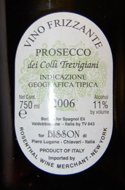 A vintage dated Prosecco?! Now thats serious! And this one IS serious. A vintage dated Prosecco?! Now thats serious! And this one IS serious.Intense salty honeydew, papaya and orange peel aromas. Intense and complex for a Prosecco. This is also serious in the mouth with dry, crisp and chalky minerals. This is a wine-lovers Prosecco, not your mother's boring and sweet Prosecco. Vibrant and reverberating. Very nice. Yummy! One Star Plus. Importer: Rosenthal Wine Merchant, New York, NY. |
|||
| Silvano Follardor Valdobbiadene Prosecco |
Drink Now-2011 | $17 | |
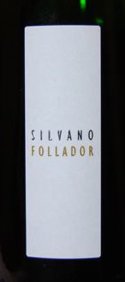 This Prosecco, from the Valdobbiadene in the Veneto region of Italy, is another winner. Not quite as dry and intense as the Bisson above, this beauty is more about pretty floral aromas and a silky, elegant flavor. Both of these are quite good and as always Prosecco makes an excellent, and inexpensive, alternative for sparkling wine. One Star Plus. This Prosecco, from the Valdobbiadene in the Veneto region of Italy, is another winner. Not quite as dry and intense as the Bisson above, this beauty is more about pretty floral aromas and a silky, elegant flavor. Both of these are quite good and as always Prosecco makes an excellent, and inexpensive, alternative for sparkling wine. One Star Plus. |
|||
White Wines:
| Dom. Berthet-Bondet Chateau-Chalon 2000 |
 |
Drink Now-2050 | $75/620ml |
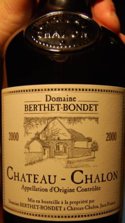 This wine deserves a bit of explanation! I've introduced you previously to the fascinating wines of the Jura (first in Issue 2 and most recently in Issue 9, a region in France that rarely gets the attention it deserves in the US. Part of the problem is that some of the wines are strange compared to standard white wines and can be an acquired taste. The most distinctive and singular wine in the Jura is called Vin Jaune, meaning "yellow wine" because of its intense golden hue. Vin Jaune are made from 100% Savagnin, similar to the Traminer grape. They are left to hang late in the season for ultra-ripeness. The resulting wine is then aged in large oak barrels for 6 years and 3 months! This is a quite long time to stay in barrel. Not only that, but the wines are not topped up, meaning no wine is added as wine evaporates. This leads to a headspace of air in the barrel. Over time, a veil of yeast develops that covers the wine, called le voile, similar to the flor that develops in some aging of Sherry. This protects the wine from oxidation but also allows a slow and subtle oxidation to occur, leading to intense, nutty and complex aromas and flavors. While Vin Jaune is produced throughout the Jura, the appellation of Chateau-Chalon only makes Vin Jaune and is considered its finest vineyards. The flavors of a fine Vin Jaune or Chateau-Chalon have been compared to Fino Sherry in their slightly oxidized nuttiness. However, the comparison stops there as these are not fortified like Sherry and tend to have weighter, more complex flavors in the best examples. They can pair very well with classic foods like Chicken cooked in Vin Jaune with Morels and especially with the local cheese, Comté! They can also age indefinitely, gaining in complexity and depth for decades. This wine deserves a bit of explanation! I've introduced you previously to the fascinating wines of the Jura (first in Issue 2 and most recently in Issue 9, a region in France that rarely gets the attention it deserves in the US. Part of the problem is that some of the wines are strange compared to standard white wines and can be an acquired taste. The most distinctive and singular wine in the Jura is called Vin Jaune, meaning "yellow wine" because of its intense golden hue. Vin Jaune are made from 100% Savagnin, similar to the Traminer grape. They are left to hang late in the season for ultra-ripeness. The resulting wine is then aged in large oak barrels for 6 years and 3 months! This is a quite long time to stay in barrel. Not only that, but the wines are not topped up, meaning no wine is added as wine evaporates. This leads to a headspace of air in the barrel. Over time, a veil of yeast develops that covers the wine, called le voile, similar to the flor that develops in some aging of Sherry. This protects the wine from oxidation but also allows a slow and subtle oxidation to occur, leading to intense, nutty and complex aromas and flavors. While Vin Jaune is produced throughout the Jura, the appellation of Chateau-Chalon only makes Vin Jaune and is considered its finest vineyards. The flavors of a fine Vin Jaune or Chateau-Chalon have been compared to Fino Sherry in their slightly oxidized nuttiness. However, the comparison stops there as these are not fortified like Sherry and tend to have weighter, more complex flavors in the best examples. They can pair very well with classic foods like Chicken cooked in Vin Jaune with Morels and especially with the local cheese, Comté! They can also age indefinitely, gaining in complexity and depth for decades.The aromas here are fascinating with classic notes of complex roasted nuts, curry spices, getting more and more complex as it sat. This developed an interesting meaty, savory aroma that I can only describe as chicken bouillon and fat with myriad spices and nuts. In the mouth this is velvety and enveloping until the intense, bright finish kicks in. Nutty and rich yet with a strong back end of lingering layers of tart fruits and spices. This is an infant in terms of its evolution but is already intriguing, unique and full of personality. An acquired taste? Maybe. But once you acquire it you will find wonders in this stuff! Two Stars Plus. Importer: Martine's Wines, Novato, CA. |
|||
| Guy Bossard Muscadet Sèvre et Maine Domaine de l'Ecu Expression de Gneiss 2005 |
Drink Now-2012 | $18 | |
 Guy Bossard is one of the stars of Muscadet, making several different versions from various terroirs in the region. This one, the Expression de Gneiss, comes from vines grown exclusively on gneiss soil which is a particular type of mineral soil, mostly granite and schist. Guy Bossard is one of the stars of Muscadet, making several different versions from various terroirs in the region. This one, the Expression de Gneiss, comes from vines grown exclusively on gneiss soil which is a particular type of mineral soil, mostly granite and schist.This has a fairly golden color for a Muscadet with some ripe fruit like papaya, apple sauce and hints of spice. This is a big Muscadet, with ripe, juicy apple and pear fruit flavors that are quite ripe. However, it does have some nice melon and citrus acidity on the back end to hold it all together. Not as intense, lively and etched out of stone as my favorite Muscadets but this is still very nice and a good valuel. One Star. Importer: Kysela Pere et Fils, Ltd., Winchester, VA. |
|||
| Cosecha Sherry Amontillado Superior Bodega Sacromonte |
Drink Now-Whenever | $18/500mL | |
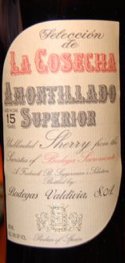 Sherry, from Jerez, is of course a fortified wine which is usually aged in oak barrels for an extended time prior to bottling. Like the wines of the Jura above (Berthet-Bondet), the wine develops a layer of yeast on its surface as it ages, called flor, giving it a unique aroma and flavor. This is an Amontillado which is a richer, darker version of Sherry from extended aging. In this case, the wine has aged in barrel about 15 years prior to bottling! This gives it its characteristic richness and mellow complexity. Sherry, from Jerez, is of course a fortified wine which is usually aged in oak barrels for an extended time prior to bottling. Like the wines of the Jura above (Berthet-Bondet), the wine develops a layer of yeast on its surface as it ages, called flor, giving it a unique aroma and flavor. This is an Amontillado which is a richer, darker version of Sherry from extended aging. In this case, the wine has aged in barrel about 15 years prior to bottling! This gives it its characteristic richness and mellow complexity.Really pretty nutty aromas of marzipan, almond butter, toasted peanuts and pralines all just from the glass. Buttery and almost butterscotchy but not a sense of sweetness. The flavors are powerful, yet mellow at the same time with intesne, smokey layers of nuts, roasted walnuts and almonds, skins and shells included. Buttered bread and almond butter. The lingering flavors are quite beautiful here. This is an outstanding Amontillado! And for an extra treat, sit with a glass of this in the evening while you read Edgar Allan Poe's "The Cask of Amontillado"! Two Stars. Importer: MHW Ltd, Manhasset, NY. |
|||
| Dönnhoff Riesling Schloßböckelheimer Felsenberg Spätlese 2006 |
Drink Now-2020 | $48 | |
 Dönnhoff is the star of the Nahe region in Germany and one of the best producers in the whole country! It is quite amazing that at that level, some of his wines can be found for this relatively inexpensive! He produces many wines from various vineyards, the Felsenberg vineyard here being one of his most famous. It is not my favorite, but it is outstanding nonetheless. While it doesn't have the penetrating, etched minerality of his best wines, its vibrancy and lively fruit is balanced nicely by a citric acidity. Dönnhoff is the star of the Nahe region in Germany and one of the best producers in the whole country! It is quite amazing that at that level, some of his wines can be found for this relatively inexpensive! He produces many wines from various vineyards, the Felsenberg vineyard here being one of his most famous. It is not my favorite, but it is outstanding nonetheless. While it doesn't have the penetrating, etched minerality of his best wines, its vibrancy and lively fruit is balanced nicely by a citric acidity.Quite flirtatious on the nose with intense white fruits like white peach, grapefruit and chalk. Pure and pristine. The initial palate impression is of intense and sweet flavors, like great lemonade and pink grapefruit dusted with sugar exploding on the palate. This quickly turns to finely textured white stones with a bitter citrus zest note to close on the finish. Very fresh and lively for an 06 which can sometimes be a bit flabby. This is really a lovely, fun wine and it is hard to say anything bad about it. Two Stars. Terry Theise Estate Selections. Importer: Michael Skurnik Wines, Syosset, NY. |
|||
| Garlider Müller Thurgau Südtirol, Eisacktaler Alois Kerschbaumer Alto-Adige Valle Isarco 2006 |
Drink Now-2011 | $18 | |
 This is a wine from the north of Italy made from a grape called Müller Thurgau which was initially a cross between Riesling and Silvaner. This is a wine from the north of Italy made from a grape called Müller Thurgau which was initially a cross between Riesling and Silvaner.This one has a pretty, floral, gooseberry and grass nose followed by bright and grassy flavors. Simple, but tasty and fresh. Not gonna blow you away, but this drinks very nicely. One Star. Importer: Oliver McCrum Wines, Richmond, CA. |
|||
| La Pepière (Ollivier) Clos des Briords VV Muscadet Sèvre et Maine 2007 |
Drink Now-2018 | $15 | |
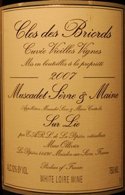 I reviewed the 2006 of this wine in Issue 7. This old vine cuvée from Pepière is one of my favorite one or two Muscadets year in and year out. I found this one to be just the slightest notch below the 06, but better for current drinking whereas the 06 seems to need some time. I reviewed the 2006 of this wine in Issue 7. This old vine cuvée from Pepière is one of my favorite one or two Muscadets year in and year out. I found this one to be just the slightest notch below the 06, but better for current drinking whereas the 06 seems to need some time.A very mineral nose, gunflint and granite, white honeydew melon and grapefruit. This gives the sense of nobility, depth and complexity despite its young age and meager price tag. Intense granite and salty minerals coat your palate. More etched and mineral driven than the Bossard Muscadet above. This should drink well young and age nicely too. It is a hint lighter than the 2006 which is even more intense and penetrating. Both are glorious examples of the appellation and stupendous values. Back up the truck! Two Stars. Louis/Dressner Selections. Importer: LDM Wines, Inc., New York, NY. |
|||
| Puffeney 2003 Arbois Savagnin |
 |
Drink Now-2016 | $30 |
 Another Jura wine here, this one from the "Puff Daddy"! Puffeney is one of the old producers in the Jura, making some of the best wines in Arbois. He makes several whites and reds including a shockingly good Vin Jaune and a Vin de Paille. This one is his basic Savagnin, which is aged in oak, but not for as long as his Vin Jaune. Another Jura wine here, this one from the "Puff Daddy"! Puffeney is one of the old producers in the Jura, making some of the best wines in Arbois. He makes several whites and reds including a shockingly good Vin Jaune and a Vin de Paille. This one is his basic Savagnin, which is aged in oak, but not for as long as his Vin Jaune.An almost chemical aroma, that my wife described as "Aqua Net" leads to savory aromas of roasted nuts, honey and aged cheese. The flavors really explode on the palate here though, intense, deep, and passionate. This, like the Chateau-Chalon up above, maybe a bit of an acquired taste with its pungent flavor and slightly oxidized character but it is a taste worth exploring. A unique wine with flavors similar to a Fino Sherry but with more depth and more substance to chew on. Great with Comté cheese and walnuts. The pungent, tangy and long finish leaves you wanting more. Really outstanding. Two Stars Plus. Importer: Rosenthal Wine Merchant, New York, NY. |
|||
| Salomon Undhof Wieden Tradition Grüner Veltliner 2004 |
Drink Now-2016 | $22 | |
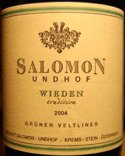 This outstanding producer in Austria makes a range of excellent Grüner Veltliner and Rieslings. This outstanding producer in Austria makes a range of excellent Grüner Veltliner and Rieslings.This is a sneaky wine, initially not showing a whole lot, but then subtle honeydew, hay and talc slowly emerge as if out of hibernation. Never in your face, just lurking beneath the surface. Smokey, with gunflint-like inner mouth perfume with a tight, steel-like finish. Nice firm acid and minerality but seems like a smooth metal rather than an etched grainy minerality. Intense and vibrant. Great with food. One Star Plus. Terry Theise Estate Selections. Importer: Michael Skurnik Wines, Syosset, NY. |
|||
Red Wines:
| Charles Joguet Chinon Clos du Chêne Vert 2005 |
 |
Drink 2015-2030 | $42 |
 What more can be said about Joguet that hasn't been said already? Joguet has been a star of the Chinon appellation for years, making some of the most convincing wines from this region that grows red wines mostly from the Cabernet Franc grape. While Cab Franc is a minor grape (for the most part, with exceptions in Cheval Blanc and others) in Bordeaux, it is the grape in Chinon. The vineyard was bought relatively recently by Joguet and replanted. It is now one of his best terroirs. What more can be said about Joguet that hasn't been said already? Joguet has been a star of the Chinon appellation for years, making some of the most convincing wines from this region that grows red wines mostly from the Cabernet Franc grape. While Cab Franc is a minor grape (for the most part, with exceptions in Cheval Blanc and others) in Bordeaux, it is the grape in Chinon. The vineyard was bought relatively recently by Joguet and replanted. It is now one of his best terroirs.This is what great Chinon is about. Deep, deep blackberry, cassis liqueur, cherry and wild herbs. In the mouth, black and dense with layers of ripe but vibrant fruit. Very young and primary at present but has great balance, texture and a subtlety lurking beneath the powerful initial punch. This really needs 10 years at least to start to show its best. If you drink it now, give it a good decant for an hour or more. Two Stars Plus. Importer: Kermit Lynch Wine Merchant, Berkeley, CA. |
|||
| Domaine du Joncier Lirac 2005 |
Drink Now-2015 | $17 | |
 Lirac is a Southern Rhone village which produces rustic but complex wines from typical southern grapes like Grenache, Mourvedre and Syrah. This producer is one of the best in the region. Lirac is a Southern Rhone village which produces rustic but complex wines from typical southern grapes like Grenache, Mourvedre and Syrah. This producer is one of the best in the region.This 2005 is rich and tasty, definitely a value at the reasonable price tag. Intense pepper and wild, brambly red fruits dominate the nose while the flavors are dense, intense and spicy. This compliments rich, spicy foods nicely and definitely feels like a typical, burly and lusty southern French red, but with a spicy, bright feel that makes it very food friendly. Excellent value. One Star Plus. Importer: Kermit Lynch Wine Merchant, Berkeley, CA. |
|||
| Domaine La Tour Vieille Collioure "La Pinède" 2005 |
Drink Now-2020 | $20 | |
 Collioure is a beautiful Mediterranean region on the French coast not far from the Spanish border. The region is known for its sun drenched red wines. Nearby Banyuls produces a rich, red fortified wine similar to Port. These are made from typical southern French grapes with high proportions of Grenache followed by Mourvedre, Syrah and others. Collioure is a beautiful Mediterranean region on the French coast not far from the Spanish border. The region is known for its sun drenched red wines. Nearby Banyuls produces a rich, red fortified wine similar to Port. These are made from typical southern French grapes with high proportions of Grenache followed by Mourvedre, Syrah and others.This one is all about fun Mediterranean sunshine. Delicious mouthful of blueberry and blackberry fruit accented by spices and Provençal herbs. Chewy and gulpable, drink it now for its fun ripe young fruit. Or stick it in the cellar and drink it later for more complexity and suavité. One Star Plus. Importer: Kermit Lynch Wine Merchant, Berkeley, CA. |
|||
| Puffeney Arbois Vieilles Vignes 2003 |
Drink Now-2019 | $23 | |
 Here is one of Puffeney's interesting red wines from the Jura. This one, from his oldest vines (vieilles vignes means "old vines"), is a blend of three different grapes, Poulsard, Trousseau and Pinot Noir from the hot vintage of 2003. Here is one of Puffeney's interesting red wines from the Jura. This one, from his oldest vines (vieilles vignes means "old vines"), is a blend of three different grapes, Poulsard, Trousseau and Pinot Noir from the hot vintage of 2003.Spicy and herby aromas with a hint of woodsiness. There is a touch of alcoholic heat but not enough to really detract from the wine. Very pretty and complex and with some air this got more mellow, meaty and even more interesting, boding well for its future. This is not a big wine, rather it is a caressing and pretty wine. A bit diffuse and alcoholic at first but still quite balanced, pretty and fine. Drinks very well now but seems balanced enough to age in the short to mid term. One Star Plus. Importer: Rosenthal, New York, NY. |
|||
Dessert Wines:
| Porto Krohn Colheita 1987 |
Drink Now-Whenever | $40 | |
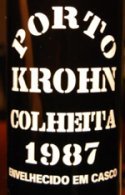 If you haven't experienced Port yet, go read our new sections on fortified wines and Port first, then grab a bottle, maybe some blue cheese, and sit back and enjoy! This one is a Colheita, basically a vintage Tawny Port, aged for may years in barrel before bottling. If you haven't experienced Port yet, go read our new sections on fortified wines and Port first, then grab a bottle, maybe some blue cheese, and sit back and enjoy! This one is a Colheita, basically a vintage Tawny Port, aged for may years in barrel before bottling.My notes for the nose of this wine said "Wow." Intense celery, caramel, mustard seed and pine cones from Mariposa Grove! Peet and scotch too, gets quite complex as it breaths in the glass. This is quite pretty. Despite its age, this is still bright and a bit piney in the mouth but velvety and warming with smokey black fruits. Herb complexity gives an interesting brightness and complexity. Turns to silk on the finish with a cool and refreshing feel. Yum. Over two days this mellowed and got more smokey. A very nice Colheita! Two Stars. Importer: Megawine, Inc., Van Nuys, CA. |
|||
| Quinta do Noval 10 Year Old Tawny Porto |
Drink Now-Whenever | $27 | |
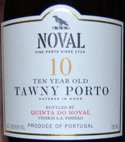 Another Port here. This one is also a Tawny, aged in oak barrels. But rather than coming from a single vintage like the previous wine, this is a blend of vintages with an average age of 10 years. Another Port here. This one is also a Tawny, aged in oak barrels. But rather than coming from a single vintage like the previous wine, this is a blend of vintages with an average age of 10 years.Peppery buttered nuts and figs introduce spicy flavors that are on the drier side of Port. More simple than the previous wine but still very tasty and a nice value. One Star Plus. Importer: Vintus, LLC, Pleasantville, NY. |
|||

Have a Reader Tip or a Question? Contact Me!
Looking for Wine or Wine Tasting Related Info? Search our site!
© 2008 Poor Man's Guide to Fine Wine. All Rights Reserved.
Search This Site

Site Sponsors

Peter Liem's
Champagne Guide

World's Best Grilling eBook!
 Decanting wine, the process of pouring a bottle of wine out into another container called a decanter, is not just for show! Sure, a beautiful crystal decanter full of wine on the table looks sophisticated, elegant and showy, but thats not its only purpose. Decanting wine is an ancient practice that serves several functions, the three most significant being aesthetics, getting rid of sediment and oxygenation. Below I will explain each and give instructions on how to do it!
Decanting wine, the process of pouring a bottle of wine out into another container called a decanter, is not just for show! Sure, a beautiful crystal decanter full of wine on the table looks sophisticated, elegant and showy, but thats not its only purpose. Decanting wine is an ancient practice that serves several functions, the three most significant being aesthetics, getting rid of sediment and oxygenation. Below I will explain each and give instructions on how to do it!
